You can freeze leftover whipped cream, and it’s a great way to store your leftovers for a prolonged period.
But to get decent results, you need to know how to go about the freezing process, depending on how you make your whipped cream (i.e., if you stabilize it or not).
Unfortunately, it’s not always as simple as grabbing your homemade whipped cream, pouring it into a container, and freezing it.
If you do that with unstabilized whipped cream, you will end up with cream that’s puffed up a bit, but not even at the soft peaks stage of whipping (there’s a photo later in the article).
Interested in freezing homemade whipped cream or one of the popular commercial options?
If so, this guide is for you. Let’s get started.
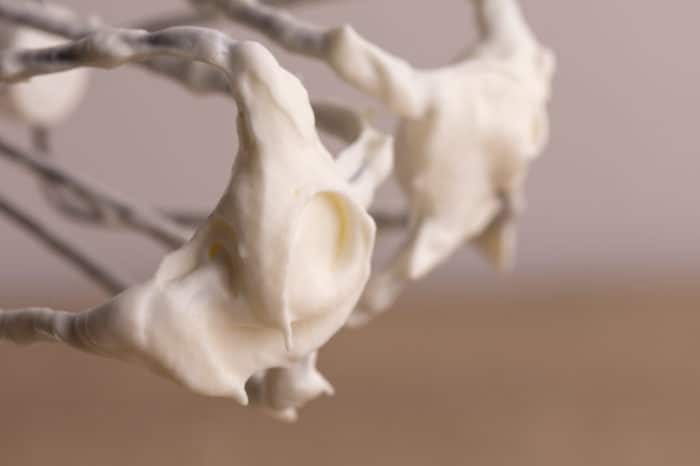
Can You Freeze Whipped Cream?
To freeze whipped cream successfully, you need to either freeze it in dollops or stabilize it before transferring the leftovers into a container. Otherwise, you’re going to end up with puffed-up half-whipped cream that looks pretty bad.
That’s the gist of it.
Below, I talk about what freezing methods I tested and share photos of the results. If you’re not interested in the details, feel free to skip to the “Two Ways To Freeze Whipped Cream” section, where I share the approaches that I recommend.
First Try: Freezing Homemade Whipped Cream
Say you’re making your whipped cream the usual way: you whip heavy cream (or whipping cream) and add a bit of powdered sugar to taste. Then you spoon all of that into an airtight container and freeze it.
When needed, you defrost it in the fridge, and here’s what you get:
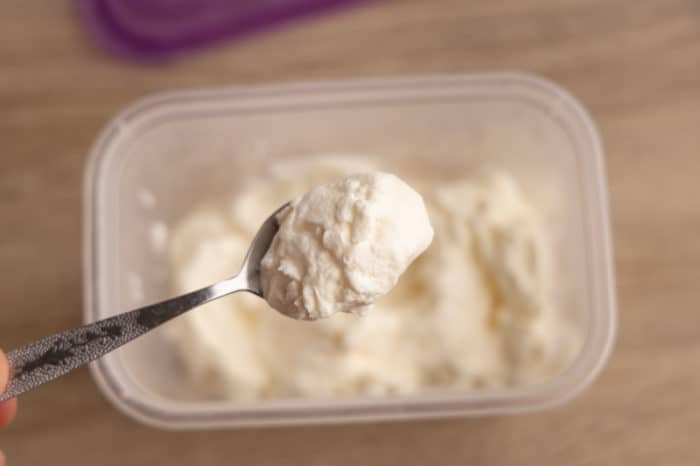
Doesn’t look that bad, does it?
But when you grab a spoon or try to pipe it, you’re left with a puffed-up and watery cream that looks like that:
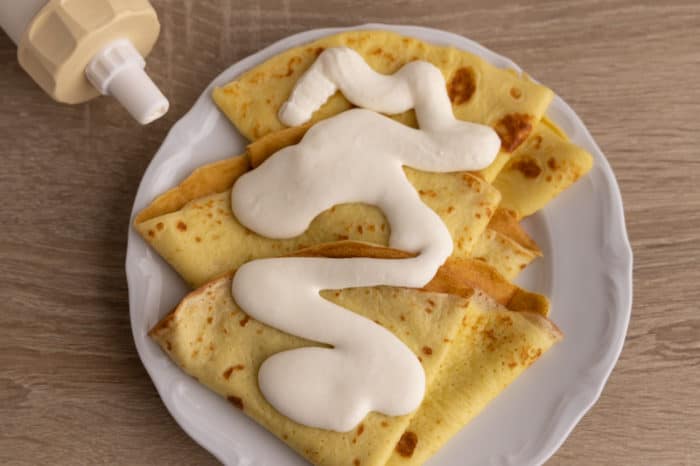
That’s a far cry from that bowl of just-whipped cream that you started with. It’s edible, but the taste and overall mouthfeel are so-so at best.
Maybe your whipped cream will freeze better in a similar scenario, and you will be happy about the results. Maybe not. I wouldn’t take that gamble.
Second Try: Dollops of Whipped Cream
Instead of freezing everything in a single container, you can freeze whipped cream in ready-to-use dollops. That approach is much better for regular homemade whipped cream.
Here are my frozen blobs (these are with stabilized whipped cream, but unstabilized works well too):
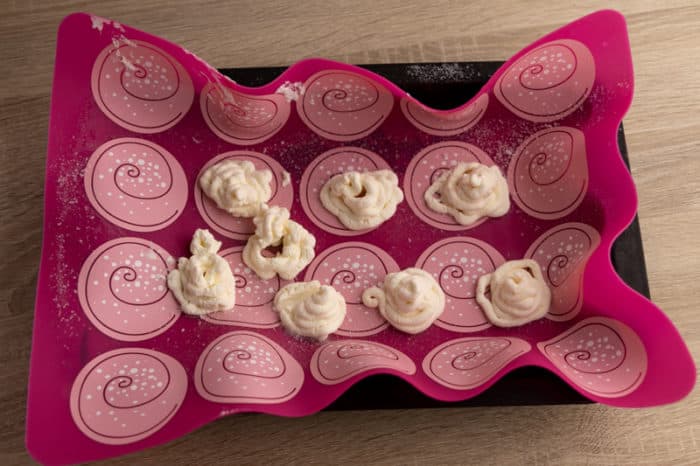
And a few of them after defrosting in the fridge on some muffins:
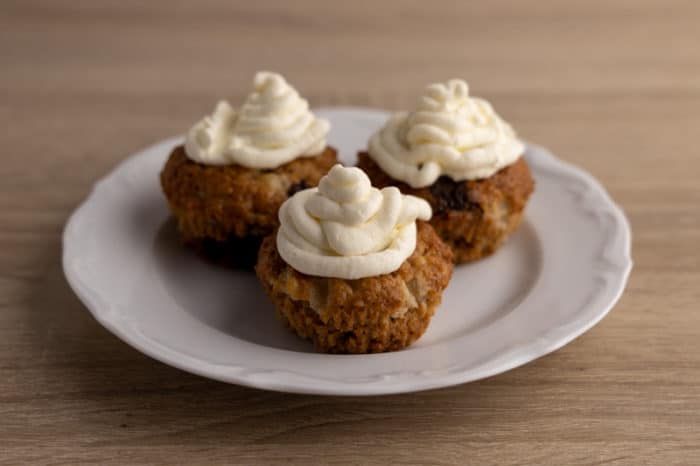
The dollops aren’t as stiff as the whipped cream was right after whipping, but they hold shape pretty well.
The main downside of the dollops approach is that it’s best to defrost them on whatever you want to put them on eventually. So, for example, if you want them to end up on your muffins, place frozen blobs on them and let them thaw in the fridge.
If you defrost the dollops all by themselves, transferring them onto anything is pretty much impossible without them losing their shape. And I wouldn’t expect re-piping the whipped cream to work all that great, especially if the cream isn’t stabilized..
Long story short, it’s a decent way to freeze homemade whipped cream. Of course, it has its downsides, but you can work around them pretty well when you’re aware of them.
Best Results: Freezing Stabilized Whipped Cream
The third time around, I tested freezing stabilized whipped cream, and it worked really well.
I tested freezing it in bulk in a container (and piping after defrosting), and using the dollops approach mentioned above. Both worked really well.
Here’s my container of stabilized whipped cream after defrosting in the fridge:
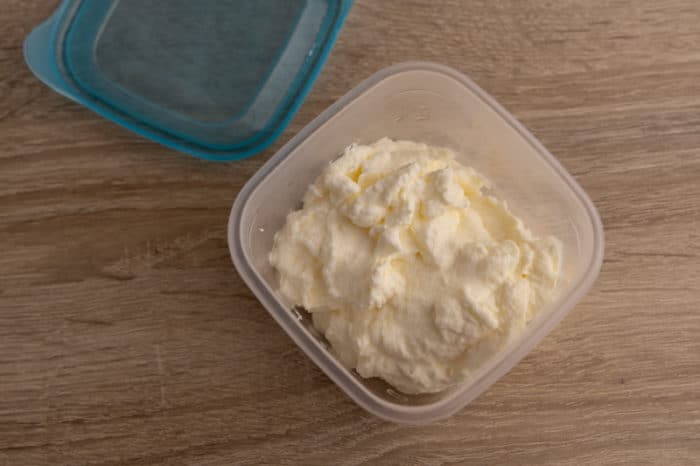
Looks a bit better than the unstabilized variety, doesn’t it?
But what’s much more important is that you can still pipe it, and it holds shape exactly as you would like it to. Here’s that same cream after piping:
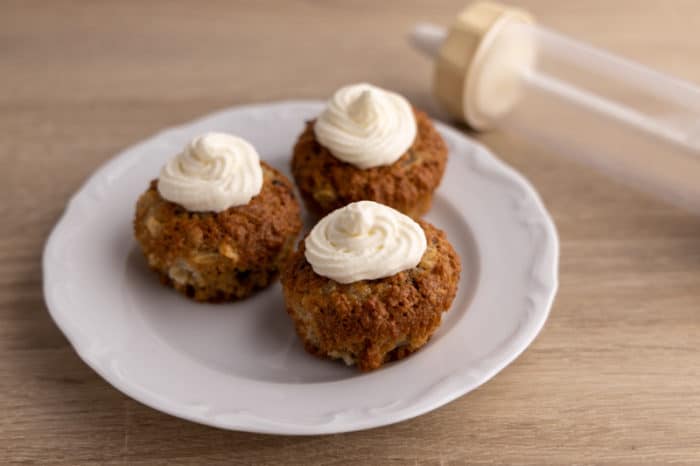
As you can tell, it looks pretty much like fresh whipped cream. It might be a bit softer than before freezing, but it holds shape well and isn’t watery by any means.
In other words, it’s a clear winner of the competition. And, as you might imagine, freezing stabilized whipped cream in dollops works well too.
Stabilization Methods
There are at least several methods to stabilize whipped cream, and some work better than others.
I used a commercial whipped cream stabilizer from Dr. Oetker, and I suggest you use a commercial one as well (go with whichever brand you like or have available). These pretty much guarantee results.
If you’re familiar with one of the other methods of stabilizing whipped cream at home and happy about the results, feel free to use it instead.
Two Ways To Freeze Whipped Cream
Below, I talk about two methods of freezing whipped cream:
- in a container
- in ready-to-use dollops
The first approach is versatile because you can use the defrosted whipped cream the same way you use fresh whipped cream. You can add it to your desserts, pipe it onto muffins or ice cream, or grab a couple of scoops to top your cup of coffee.
The only downside is that it has to be stabilized whipped cream. Otherwise, the results will be mediocre at best (check the previous section for photos).
The dollops method works okay for unstabilized whipped cream and great for the stabilized variety. If you know exactly how the whipped cream needs to be shaped for your dessert (or what have you), you might as well pipe the blobs right now and not have to worry about it later on.
Also, if you don’t have a way to stabilize the cream before freezing it, the dollops are your best bet. Or at least that’s been my experience.
Now, it’s time to choose the method you’re interested in using, and get your whipped cream frozen.
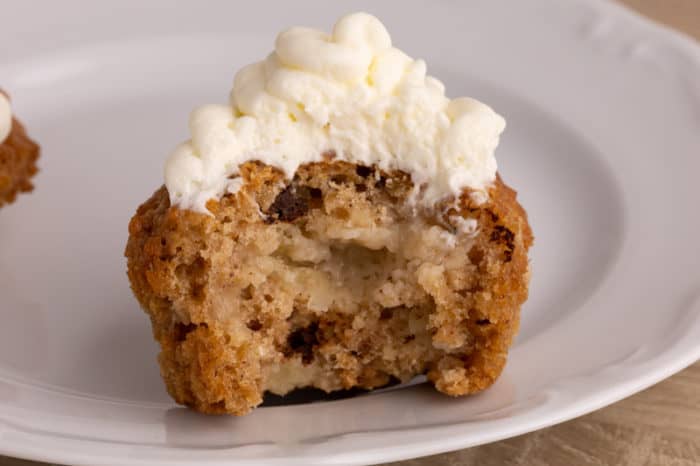
Freezing Stabilized Whipped Cream in a Container
- Grab an airtight container or more.
- Portion leftover stabilized whipped into the container(s). Divide the leftovers into as many containers as it makes sense. Whipped cream freezes solid, so grabbing only a spoon or two as needed isn’t an option. Because of that, if you have a ton of whipped cream left, it’s probably best to divide it into a few smaller containers. You can always defrost more than one container if need be.
- Seal the containers and transfer them into the freezer.
That’s it. The process is super simple and takes only a minute or two.
Once again, I want to remind you that you should go with this method only if your whipped cream is stabilized. Otherwise, it will most likely lose shape after defrosting, and you will end up with a soft watery mess that’s not even at the soft peaks stage of whipping.
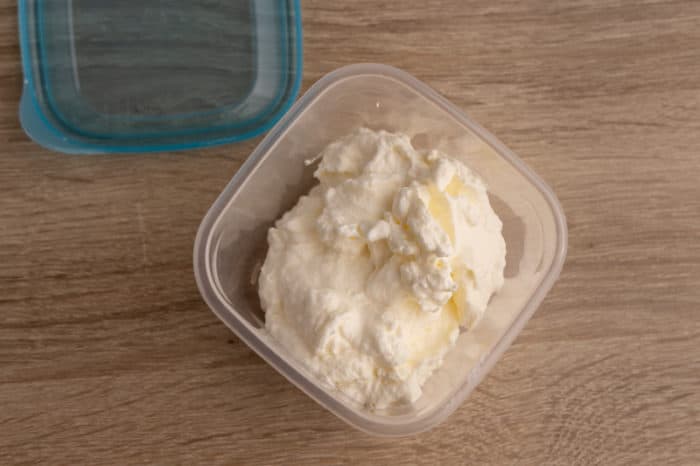
Freezing Whipped Cream in Dollops
- Line a cookie sheet with parchment paper or a silicone mat.
- Pipe your whipped cream onto the cookie sheet. Go with sizes and shapes that work for how you’re going to use the cream after defrosting. If you don’t need specific sizes or shapes, just drop some spoon-sized dollops instead. Remember that smaller ones will hold shape after defrosting better than large ones, especially if your whipped cream isn’t stabilized.
- Place the baking sheet in the freezer and keep there until the blobs are frozen. Two to three hours is usually enough, but you can leave them in there overnight just as well.
- Transfer the frozen blobs into a freezer bag or airtight container. This way, you get your cookie sheet and a lot of space in the freezer back. Plus, the cream is ready to be frozen for the long term. Add a label with the name and date if you find it useful.
- Return the container or bag in the freezer.
This process is a tad bit more complicated than the freezing in a container approach because we have the extra step of pre-freezing the dollops. Unfortunately, you can’t do everything in one go, but that’s the nature of pre-freezing.
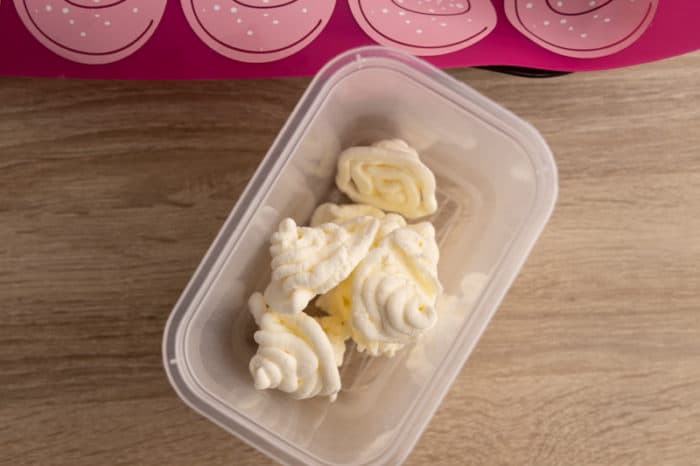
How To Defrost Whipped Cream
You can defrost frozen whipped cream in the fridge, or you use it frozen. Both approaches can get you good results, and you should choose one based on how your whipped cream is frozen and how you want to use it.
Defrosting Whipped Cream in the Fridge
This is by far the best way to defrost whipped cream because the cream actually retains its shape and looks and tastes alright, no matter how you use it.
Here’s how to tackle defrosting, depending on how you froze it:
Defrosting Whipped Cream Frozen in a Container
This is as simple as it gets. You transfer the container from the freezer into the fridge, and after 3 to 6 hours (depending on the amount), you have your whipped cream defrosted and ready for use.
You can scoop it with a spoon, pipe it, or use however you like.
Defrosting Frozen Whipped Cream Dollops
The best way to go about that is to place the frozen dollops on top of whatever you want to top with them and place everything in the fridge until the cream defrosts.
Say you want to top your muffins with those blobs. You start by placing them frozen on the muffins, like so:
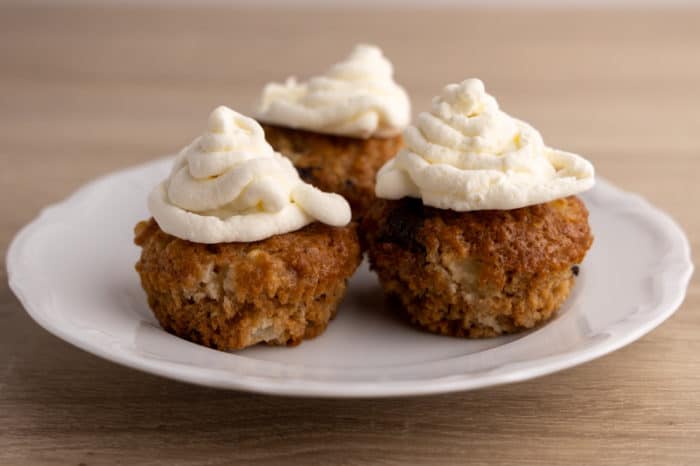
Then you place the plate in the refrigerator for an hour or so, so that the whipped cream defrosts. Once that’s done, the muffins are ready to eat:

If you don’t want the frozen whipped cream blobs to melt, don’t place them on anything warm. If you got those muffins fresh out of the oven, let them cool first.
Using Frozen Whipped Cream Without Defrosting
This option works only if you have your whipped cream frozen in dollops. That’s pretty obvious.
Now, the best way to use frozen whipped cream without defrosting it first is to melt it on top of a hot drink, like a cup of hot chocolate or coffee. In those cases, you’re perfectly fine with the cream melting.
Another option, often mentioned in the interwebs, is to top a dish you just cooked with frozen dollops. Fresh muffins or pancakes first come to mind.
The issue here is that while the heat from the dish will defrost the whipped cream fairly fast, it will also melt the bottom layer (or the whole thing). And you’ll end up with something like this (or much worse):
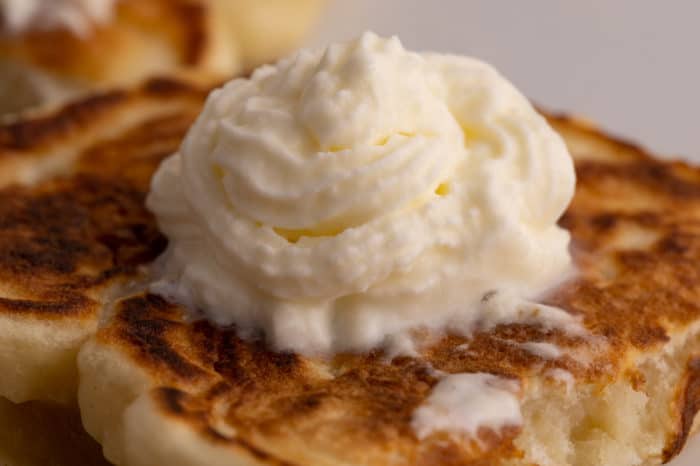
For the photo above, I waited for the pancake to cool down a bit before I dropped the cream on its surface. Otherwise, half of it would melt, and it would be a total mess.
The wait-until-it’s-not-hot-anymore approach doesn’t work that well either.
If the dollop isn’t almost flat, your whipped cream will sit in an awkward spot for 10 to 20 minutes, where the bottom is soft or melting, but the top is still solid and not ready for eating.
Again, not ideal.
Long story short, reserve this option for melting your frozen whipped cream in hot drinks. Otherwise, defrost them in the fridge.

How To Use Frozen and Defrosted Whipped Cream
As I already mentioned, you can use frozen and defrosted whipped cream the same way you use fresh whipped cream. You just need to go with the freezing approach that makes the most sense in your circumstances and defrost the cream properly.
I covered both above.
Now that you’re ready to use your whipped cream, feel free to use it in:
- desserts
- topping cakes and baked goods, layer cakes and cupcakes
- topping slices of pie, fruit tarts, and crumbles
- frosting a coffee or hot chocolate
- on top of ice cream or milkshake
- anything else you might think of
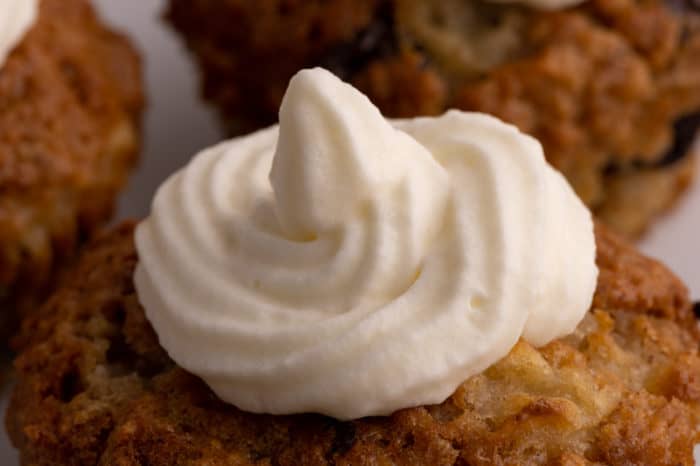
FAQs on Freezing Whipped Cream
Below, I cover a few of the most popular questions related to freezing whipped cream.
Can You Freeze Aerosol Whipped Cream?
Aerosol whipped cream, sometimes called canned whipped cream, is okay to freeze, but not in a can.
You need to either pour all the whipped cream into a container or freeze it in blobs. Both options are (almost always) okay.
Aerosol whipped cream typically contains something that stabilizes the cream, so you can consider it stabilized. Because of that, both freezing options can work just fine.
But if yours says it doesn’t contain any stabilizers, stick to freezing it in the dollop form.
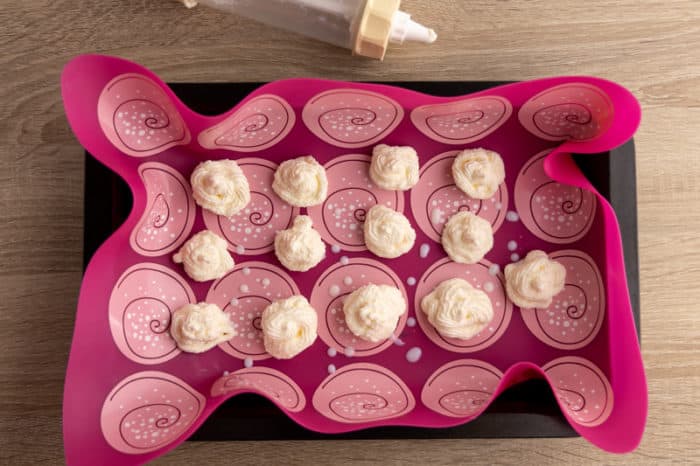
Can You Freeze Reddi Wip?
Reddi Wip is a popular aerosol whipped cream, and you can freeze the contents of the can after dispensing them. But, again, don’t even think about freezing the can itself.
Can You Refreeze Cool Whip?
It’s perfectly fine to refreeze Cool Whip, and you can do that multiple times.
The procedure works like this:
- You place Cool Whip in the fridge and defrost it overnight.
- You scoop as much whipped cream as you need.
- You return Cool Whip into the freezer until you need it next time around.
- Repeat until you use up the whole container of the whipped topping.